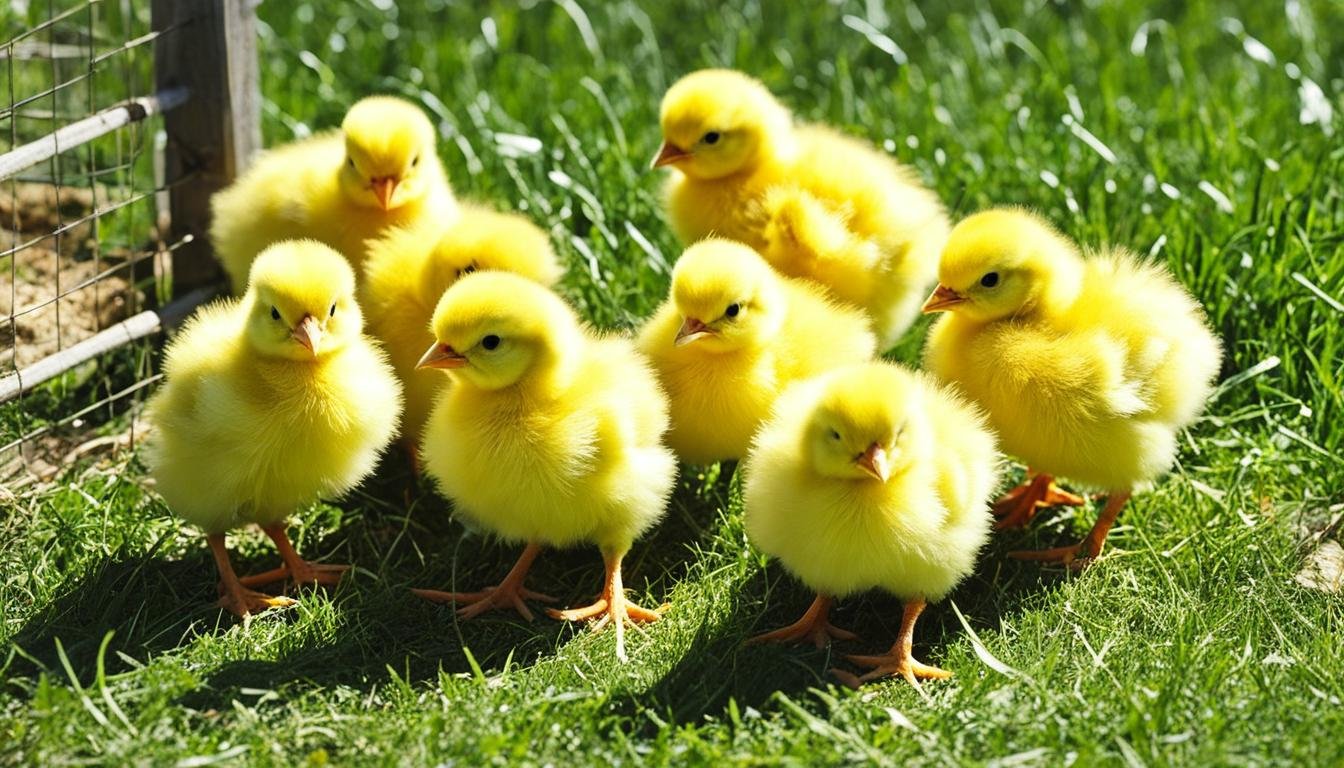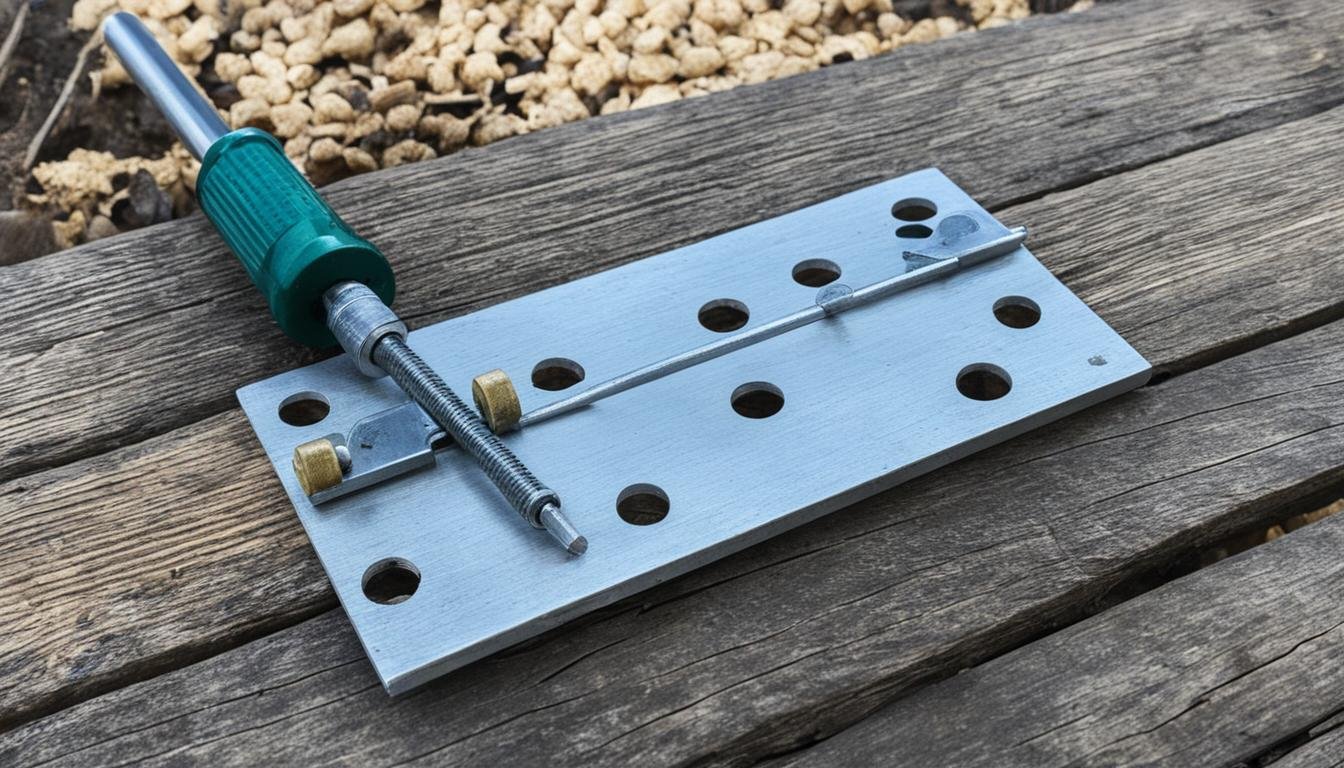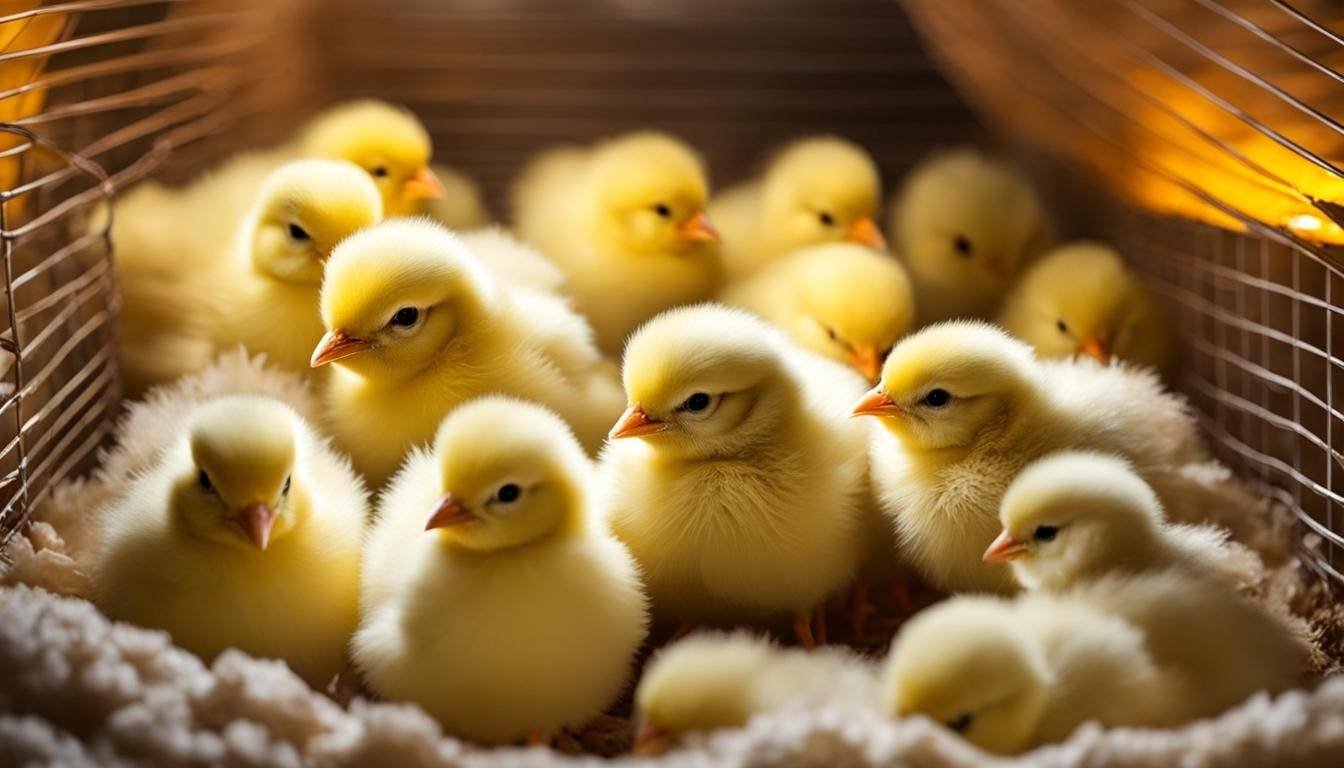Welcome to our guide on chick care! If you’re wondering how old chicks have to be to go outside, you’ve come to the right place. We’ll provide you with the essential information to ensure your chicks are ready for outdoor adventures.
One common question is, “What is the minimum age for chicks to go outside?” Generally, chicks can start going outside at around 6 to 8 weeks of age. However, it’s important to consider a few factors to determine the ideal time for your chicks.
To ensure the safety and comfort of your chicks, the outdoor temperature should be at least 50 degrees Fahrenheit. Additionally, your chicks should be fully feathered, as feathers provide insulation against the elements. If these conditions are met, your chicks should be ready to make the transition from the brooder to the chicken coop and explore the great outdoors.
When moving the chicks to their new home, it’s crucial to acclimate them slowly. Provide them with the same starter-grower feed they have been eating. If you plan to let the chicks free-range outside of the coop, it’s recommended to supervise them until they are acclimated to their surroundings and familiar with their new home.
In the next sections, we’ll dive deeper into the transition process, tips for outdoor acclimation, maintaining a clean and secure coop, and feeding and nutrition for growing chicks. Let’s ensure your chicks thrive and enjoy their outdoor adventures!
Transitioning from the Brooder to the Chicken Coop
When it comes to transitioning chicks from the brooder to the chicken coop, there are a few important steps to follow. This process ensures that the chicks adjust well to their new environment and continue to thrive. Let’s take a look at the key considerations:
1. Remove Supplemental Heat
At around 6 weeks of age, chicks are typically fully feathered and can tolerate cooler temperatures. Therefore, it’s time to remove the supplemental heat from the brooder. This helps the chicks gradually adapt to the ambient temperature of the chicken coop.
2. Move the Brooder to the Coop
There are two options for moving the chicks from the brooder to the coop: either physically move the entire brooder or use a portable pet carrier to transport them. Slowly move the brooder or carrier into the chicken coop, allowing the chicks to become familiar with their new surroundings.
3. Introduce the Chicks to the Coop
Open the brooder or carrier inside the coop, allowing the chicks to explore their new home. Show them the location of their feed and water so they can easily find their essential resources.
4. Gradual Outdoor Time
If you plan to let the chicks free-range outside of the coop, it’s best to start with supervised short periods of outdoor time. Gradually increase the duration as the chicks become more comfortable and acclimated to their surroundings.
5. Provide Adequate Nourishment
Consistency is key when it comes to nourishing your chicks. Before allowing them outside, offer them their complete starter-grower feed to ensure they stay well-nourished throughout their transition to the coop.
Tips for Transitioning Chicks to the Outdoors
To help chicks acclimate to the outdoors, there are a few tips to keep in mind. Firstly, consider the weather and make sure it’s suitable for the chicks to go outside. If the outdoor temperature is warm enough and there are no extreme weather conditions, it’s safe to start introducing the chicks to the outside environment.
Start with supervised outdoor time in a small designated area, such as a garden, and gradually increase the duration as the chicks become more comfortable. This controlled exposure allows them to experience the sights, sounds, and smells of the outdoors while still being closely monitored. It’s important to ensure that the designated area is securely enclosed to prevent any escapes or predator access.
Before letting them outside, offer them their complete starter-grower feed and fresh water so they are adequately nourished. This ensures they have the necessary nutrients to support their growth and development as they explore their new surroundings. Keeping their feed and water available in their designated outdoor space will help them understand that it’s a safe and familiar environment.
To create a smooth transition, it’s crucial to maintain a routine for free-ranging time. Set a consistent schedule for when you let the chicks outside, gradually increasing the duration based on their comfort level. By establishing a routine, the chicks will come to expect and look forward to their outdoor time, making it easier for them to adjust.
It’s important to always supervise the chicks during their outdoor adventures. This helps ensure their safety from predators such as hawks, foxes, or stray cats. By keeping a watchful eye, you can intervene if any potential dangers arise and provide immediate protection for your chicks.
In summary, transitioning chicks to the outdoors requires careful planning and consideration. By following these tips, you can help acclimate your chicks to their new outdoor environment, ensuring their safety, and providing them with the opportunity to explore and thrive.
Keeping the Chicken Coop Clean and Secure
Maintaining a clean and secure chicken coop is crucial for the health and safety of your chicks. A clean coop not only promotes good hygiene but also helps prevent the spread of diseases and pests. Additionally, a secure coop protects your chicks from predators, ensuring their well-being and allowing them to thrive.
Chicken Coop Cleanliness
Regular cleaning of the chicken coop is essential to maintain a healthy environment for your chicks. Here are some steps to follow:
- Regularly remove manure, wet litter, and old feed waste from the coop. This prevents the buildup of bacteria and odors that can harm your chicks’ health.
- Disinfect feeders and waterers on a weekly basis to minimize the risk of contamination.
- Occasionally clean and sanitize the entire coop using warm water and a suitable cleanser. This helps eliminate any remaining bacteria or parasites that may pose a threat to your chicks.
By maintaining cleanliness in your coop, you create a healthier environment for your chicks to grow and thrive.
Secure Coop Design
Ensuring the security of your chicken coop is essential to protect your chicks from predators. Here are some tips to consider:
- Provide enough space for your chicks inside the coop. Overcrowding can lead to stress and increased vulnerability to diseases.
- Separate young pullets and cockerels from older chickens until they reach a similar size. This allows for close monitoring and prevents fighting or illness from spreading.
- If introducing new birds to an existing flock, consider placing the two groups in side-by-side runs before full integration. This helps them become familiar with each other and reduces the risk of aggression or territorial disputes.
By implementing these measures, you ensure a safe and secure environment for your chicks, allowing them to grow and thrive without unnecessary risks.
Chicken Coop Cleanliness and Security Planning
A systematic approach to maintaining chicken coop cleanliness and security is key to the well-being of your chicks. Consider creating a schedule to keep track of your cleaning and maintenance tasks. Here’s an example:
| Task | Frequency |
|---|---|
| Remove manure, wet litter, and old feed waste | Weekly |
| Disinfect feeders and waterers | Weekly |
| Clean and sanitize the entire coop | Monthly |
By following a consistent schedule, you ensure that your coop remains clean and secure, providing a healthy and safe environment for your beloved chicks.
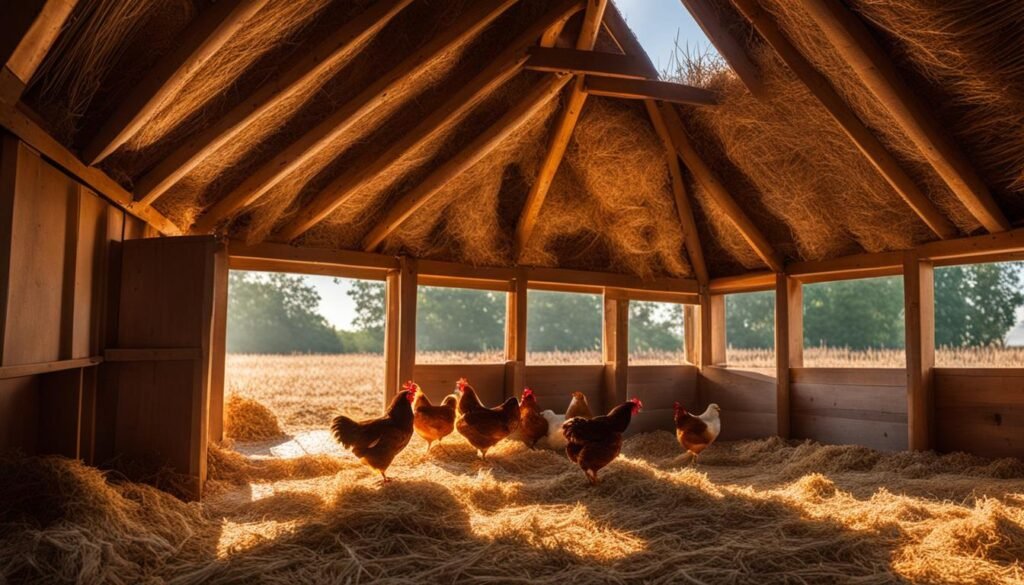
Feeding and Nutrition for Growing Chicks
Feeding growing chicks a balanced and nutritious diet is essential for their healthy development. To ensure optimal growth and well-being, it’s important to focus on their feeding habits and provide them with the right nutrition.
Chick Starter-Grower Feed
Chicks should be fed a complete starter-grower feed from day 1 to week 18. These feeds are specifically formulated to provide all the necessary nutrients for their growth and development. It’s crucial to continue offering the same complete chick starter feed that they have been eating since day 1.
Note: If your chicks were initially started on a medicated feed, it’s important to continue with that until they reach maturity. The medication is designed to prevent common diseases and should be administered as directed.
Avoid Treats and Supplements
It’s best to avoid giving chicks treats or supplements until they reach 18 weeks of age. Their primary source of nutrition should come from the complete starter-grower feed. This feed is carefully balanced to provide all the necessary vitamins, minerals, and proteins for healthy growth.
Transition to Layer Feed
Once your chicks reach 18 weeks of age, laying breeds can be transitioned to a complete layer feed. Layer feeds are specifically formulated to provide the extra calcium needed for egg production. It’s important to make this transition gradually to avoid any digestive issues.
Throughout their growth, ensure that the chicks have access to fresh water at all times. Water is essential for digestion and overall hydration.
Additional Supplements
Depending on their diet and free-ranging habits, additional supplements may be needed to support their growth and health. Some common supplements include:
- Grit: Chickens need grit to help them grind down their food in their gizzards. Grit is especially important if your chicks are free-ranging and have access to coarse natural materials like gravel.
- Oyster Shells: Oyster shells provide a calcium source for laying hens. They help strengthen eggshells and prevent calcium deficiencies.
Consult with a poultry nutritionist or a local veterinarian to determine if your chicks require any additional supplements based on their specific needs.
Feeding and Nutrition Tips:
Here are some important tips to keep in mind regarding feeding and nutrition for growing chicks:
- Always provide fresh, clean water for your chicks.
- Ensure that feeders are cleaned regularly to prevent the buildup of mold or bacteria.
- Monitor your chicks’ growth and adjust their feed as necessary.
- Keep their feeding area clean and free from droppings or spilled feed.
- Observe your chicks’ behavior and appetite to ensure they are healthy and thriving.
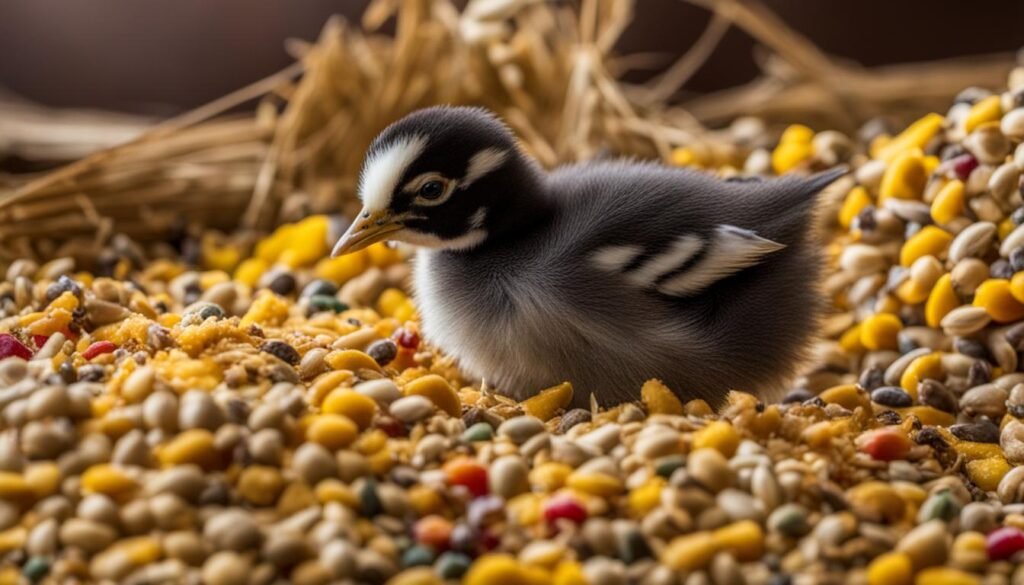
| Feed Type | Feeding Stage | Nutritional Benefits |
|---|---|---|
| Starter-Grower Feed | Day 1 to week 18 | Provides essential nutrients for growth and development |
| Medicated Feed | As directed until maturity | Prevents common diseases and promotes health |
| Layer Feed | From 18 weeks onward (laying breeds) | Extra calcium for egg production |
| Grit | As needed | Aids in digestion and grinding of food |
| Oyster Shells | As needed (laying breeds) | Source of calcium for strong eggshells |
Conclusion
Raising healthy and happy chicks requires careful attention to their needs throughout their development. Proper chick care involves gradually transitioning them from the brooder to the chicken coop, providing them with the right feed and nutrition, and creating a clean and secure environment. By following these essential steps, chicks can be prepared for their outdoor adventures and thrive as they grow into adult chickens.
When chicks are around 6 to 8 weeks old, they can generally start going outside. However, it’s important to consider factors such as temperature, acclimation, and supervision. It’s recommended to introduce chicks to the outdoors slowly and monitor their behavior, ensuring they are comfortable in their new surroundings.
Throughout the process, it’s crucial to pay close attention to chick care, providing them with a proper diet and nutrition. Feeding them a complete starter-grower feed formulated for their needs is essential for healthy development. Additionally, maintaining a clean and secure chicken coop is crucial for their overall well-being and safety from predators.
By giving chicks the care and attention they deserve, they can grow into strong and healthy chickens that will provide joy and productivity to their owners for years to come. Remember, raising healthy chicks takes time and effort, but the rewards are well worth it!

